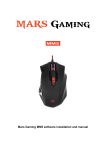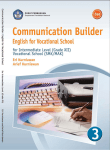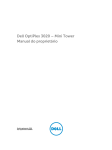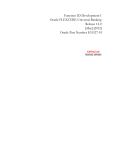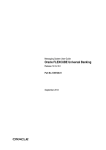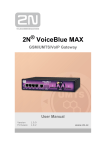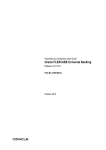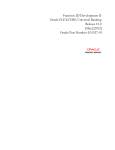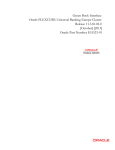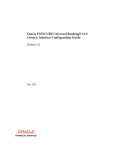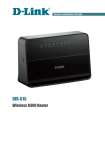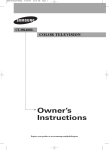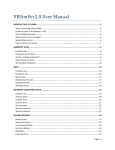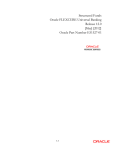Download RTGS SKN Messages Interface User Manual
Transcript
RTGS SKN Messages Oracle FLEXCUBE Universal Banking Release 12.0 [May] [2012] Oracle Part Number E51527-01 RTGS SKN Messages Table of Contents 1. ABOUT THIS MANUAL .............................................................................................................................................. 1-1 1.1 1.2 1.3 1.4 1.5 1.6 2. INTRODUCTION ......................................................................................................................................................... 1-1 AUDIENCE ................................................................................................................................................................ 1-1 ACRONYMS AND ABBREVIATIONS ............................................................................................................................ 1-1 ORGANIZATION......................................................................................................................................................... 1-1 CONVENTIONS USED IN THIS MANUAL ..................................................................................................................... 1-2 RELATED DOCUMENTS ............................................................................................................................................. 1-2 RTGS MESSAGES ........................................................................................................................................................ 2-1 2.1 INTRODUCTION ......................................................................................................................................................... 2-1 2.2 MAINTAINING DETAILS FOR RTGS INTERFACE ........................................................................................................ 2-1 2.2.1 Maintaining External System ........................................................................................................................... 2-1 2.2.2 Maintaining RTGS Interface Details ............................................................................................................... 2-2 2.2.3 Maintaining RTGS Messages ........................................................................................................................... 2-3 2.2.4 Processing Incoming RTGS Message .............................................................................................................. 2-4 2.2.5 Processing Outgoing RTGS Message .............................................................................................................. 2-4 3. SKN MESSAGES .......................................................................................................................................................... 3-1 3.1 INTRODUCTION ......................................................................................................................................................... 3-1 3.2 MAINTAINING DETAILS FOR SKN INTERFACE .......................................................................................................... 3-1 3.2.1 Maintaining External System ........................................................................................................................... 3-1 3.2.2 Maintaining SKN Interface Details .................................................................................................................. 3-2 3.2.3 Maintaining SKN Messages ............................................................................................................................. 3-3 3.2.4 Processing Incoming SKN Messages ............................................................................................................... 3-4 3.2.5 Processing Outgoing SKN Messages ............................................................................................................... 3-4 4. ANNEXURE ................................................................................................................................................................... 4-1 4.1 ACCOUNTING ENTRIES ............................................................................................................................................. 4-1 4.1.1 Accounting entries for RTGS Incoming Debit (from Central Bank) ................................................................ 4-1 4.1.2 Accounting Entries for SKN/RTGS incoming payments................................................................................... 4-1 4.1.3 Accounting Entries for SKN/RTGS outgoing payments ................................................................................... 4-3 5. SCREEN GLOSSARY .................................................................................................................................................. 5-1 5.1 FUNCTION ID LIST .................................................................................................................................................... 5-1 1. About this Manual 1.1 Introduction Oracle FLEXCUBE facilitates processing of SKN and RTGS messages for bank payments. The system dispatches and processes Incoming credit payment, Return of Incoming credit payment, Outgoing Credit Payment, Return of Outgoing Credit Payment in SKN and RTGS networks. Besides this User Manual, while maintaining the interface related details, you can invoke the context sensitive help available for each field. This help encapsulates the purpose of each field within a screen. Placing the cursor on the relevant field and striking the <F1> key on the keyboard can obtain information specific to a particular field. 1.2 Audience This manual is intended for the following User/User Roles: Role Function Back office data entry Clerks Input functions for maintenance related to the interface Back office Managers/Officers Authorization functions 1.3 Acronyms and Abbreviations Abbreviation Description System Unless and otherwise specified, it shall always refer to Oracle FLEXCUBE Corporate (FCC) system GI Generic Interface RTGS Real Time Gross Settlement SKN Sistem Kliring Nasional / Indonesia National Clearing system 1.4 Organization This manual is organized into the following chapters: Chapter 1 About This Manual – Provides an introduction to the organisation of the Manual Chapter 2 RTGS Messages – Provides an overview of the messages in RTGS network. Chapter 3 SKN Messages – Provides an overview of the messages in SKN network. 1-1 1.5 Conventions Used in this Manual Important information is preceded with the symbol. 1.6 Glossary of Icons Icons Function Exit Add row Delete row Option List 1.7 Related Documents You may need to refer to any or all of the User Manuals while working on the IF RTGS SKN Messages module: Procedures User Manual GI CS FT MS PC LC 1-2 2. RTGS Messages 2.1 Introduction Oracle FLEXCUBE supports processing of messages in RTGS network. Incoming credit payment, Return of Incoming Credit payment, Outgoing Credit payment, return of outgoing credit payment and Incoming debit are the messages dispatched and processed in RTGS networks.. 2.2 Maintaining Details for RTGS Interface You need to maintain the following details for this interface: Details of External System Details of the Interface Interface Parameterization Interface Translation 2.2.1 Maintaining External System You need to specify the external system connected to the interface by using the ‘External System Maintenance’ screen. You can invoke the ‘External System Maintenance’ screen by typing ‘GWDEXSYS’ in the field at the top right corner of the Application tool bar and clicking the adjoining arrow button. 2-1 In this screen, you can specify the following details: External System Specify ‘RTGS’ as the external system. For more details refer Maintaining External System(s) Details section of Generic Interface User Manual. 2.2.2 Maintaining RTGS Interface Details Generic Interface (GI) provides a facility to define format details and properties associated to interface file. You can maintain format details and properties associated with RTGS interface file in the ‘Interface Definition’ screen. You can invoke this screen by typing ‘GIDIFTDF’ in the field at the top right corner of the Application tool bar and clicking the adjoining arrow button. The following details are maintained for PCRTGSIN interface here: External System Specify ‘BIS’ as external system. Interface Code Specify interface code as ‘PCRTGSIN’. Interface Type Select Incoming as interface type from the adjoining drop-down list. 2-2 File Path Specify the directory path of the incoming files to be processed. File Name Specify the file name as per network. Frequency Type Select Multiple times in a day as the frequency type from the adjoining drop-down list. Incoming File Mask Select ‘Start With File Name’ as the incoming file mask from the adjoining drop-down list. The interface details and the external system details are maintained using the Interface Definition Details and External System Maintenance screens. For more details refer Specifying Interface Definition Details section of Generic Interface User Manual. 2.2.3 Maintaining RTGS Messages The following table specifies the various message types and the corresponding transaction code of RTGS Network: Seria l No Network (from Product) Message Type (Outgoin g/ Transfer Type Product Type(from Product Category) RTGS/ SKN Messa ge Name Message Description Custome r Incoming Credit Payment 607 This is an Incoming RTGS Payment to the Customer. Incomin g) 1 RTGS Incoming The Message Type received in the RTGS message will be “607” based on which the product type will be identified. Mapping between the message type and the corresponding Payment product has to be provided based on which the transaction will be created. 2 RTGS Incoming Custome r Return of Outgoing Credit Payment 610 This message is for return of Outgoing Payment. The first 16 characters of the “Payment field” in the message contain the Reference number based on which the transaction will be identified. 3 RTGS Outgoing Payment Outgoing Credit 600 This message will be generated for the “Outgoing Payment” transaction using RTGS product. 4 RTGS Outgoing Payment Return of Incoming 617 This message will be generated when the authorizer rejects the Incoming credit 2-3 Credit 5 RTGS Incoming Payment RTGS Debit Notification payment 637 2.2.4 Processing Incoming RTGS Message The interface PCRTGSINC uploads the incoming payment files through RTGS networks. The incoming files uploaded in the ASCII format is placed in a specified folder and the path is mapped to GI maintenance. Steps involved in File processing of Incoming RTGS Message:. When the file is uploaded, the network type is identified based on the file type. The file is parsed as per the message format and is uploaded in the GI interface table. From the interface table new program unit is written to call the PC service using the data available in the GI interface table. The RTGS file will be identified with RTGS file extension. The interface job is triggered manually to initiate manual processing. After the file processing and data processing, incoming job PC_PRCSINMSG is executed from the job browser screen (CSSJOBBR) After job execution, system processes the data from the GI upload table and creates Incoming payment contracts. The following validation is done as part of file parsing and it will be rejected if validation fails Incorrect credit count, debit count. Incorrect total credit amount, total debit amount. TRN code is incorrect or blank 2.2.5 Processing Outgoing RTGS Message The interface PCRTGSOUT uploads the outgoing payment files through RTGS networks. The outgoing files uploaded in the ASCII format is placed in a specified folder and the path is mapped to GI maintenance. Steps involved in File processing of Outgoing RTGS Message: All the outgoing payment contracts generated on the day along with the contracts generated after the cut-off time in the previous day is selected. All the fields required for the message is inserted into the GI upload interface table. From the interface table file is generated and placed in the directory location. A new parameter NO_OF_OUT_TXN is introduced in CSTB_PARAM. This parameter denotes the number of transaction to be grouped in a single file. If the number of transaction to be processed exceeds the count then multiple outgoing files are generated. The outgoing job PC_PRCSOUTMSG is introduced for processing outgoing file generation. After the execution of job from the job browser screen, the system: 2-4 Selects the set of contracts to be dispatched. Processes individual contracts to build the message body on per transaction basis. Based on the parameter count the individual transactions are grouped in the file and the corresponding header and footer are built. Multiple files are generated for both RTGS and SKN in case if the number of transactions exceeds the parameter count. New parameter PC_OUTFILE_PATH will be introduced in the CSTB_PARAM table. Based on the path specified in the parameter, the outgoing file is placed in the path. 2-5 3. SKN Messages 3.1 Introduction Oracle FLEXCUBE facilitates the outgoing and incoming payments with SKN network. SKN networks dispatches and processes Incoming Credit Payment, Return of Incoming Credit Payment, Outgoing Credit Payment and Return of Outgoing Credit Payment messages. 3.2 Maintaining Details for SKN Interface You need to maintain the following details for this interface: Details of External System Details of the Interface Interface Parameterization Interface Translation 3.2.1 Maintaining External System You need to specify the external system connected to the interface by using the ‘External System Maintenance’ screen. You can invoke the ‘External System Maintenance’ screen by typing ‘GWDEXSYS’ in the field at the top right corner of the Application tool bar and clicking the adjoining arrow button. In this screen, you can specify the following details: 3-1 External System Specify ‘SKN’ as the external system. For more details refer Maintaining External System(s) Details section of Generic Interface User Manual 3.2.2 Maintaining SKN Interface Details Generic Interface (GI) provides a facility to define format details and properties associated to interface file.You can maintain format details and properties associated with SKN interface file in the ‘Interface Definition’ screen. You can invoke this screen by typing ‘GIDIFTDF’ in the field at the top right corner of the Application tool bar and clicking the adjoining arrow button. The following details are maintained for PCSKNSIN interface here: External System Specify ‘BIS’ as external system. Interface code Specify interface code as ‘PCSKNSIN’. Interface Type Select Incoming as interface type from the adjoining drop-down list. File Path Specify the directory path of the incoming files to be processed. 3-2 File Name Specify the file name as per network. Frequency Type Select Multiple times in a day as the frequency type from the adjoining drop-down list. Incoming File Mask Select ‘Start With File Name’ as the incoming file mask from the adjoining drop-down list. The interface details and the external system details are maintained using the Interface Definition Details and External System Maintenance screens. For more details refer Specifying Interface Definition Details section of Generic Interface User Manual. 3.2.3 Maintaining SKN Messages The following table specifies the various message types and the corresponding transaction code of SKN Network: Seria l No Network (from Product) Message Type (Outgoing/ Payment /Collectio n Product Type(from Product Category) Message Name Customer Incoming Credit Payment S01 Incoming) 1 SKN Incoming Message Description This is an incoming SKN Payment message for the Customer. The message type received in the message will be “BMSKN01” based on which the product type will be identified. Mapping between the message type and the corresponding Payment product has to be provided based on which the transaction will be created. 2 SKN Incoming Customer Return of Outgoing Credit Payment S03 The message is the return of “Outgoing credit payment”. The first 16 characters of the “Remarks field” in the message contain the Reference number based on which the transaction will be 3-3 identified. 3 SKN Outgoing Payment Outgoing Credit S05 This message will be generated for the “Outgoing Payment” transaction using the SKN product 4 SKN Outgoing Payment Return of Incoming Credit S07 This message will be generated when the authorizer rejects the Incoming credit Payment 3.2.4 Processing Incoming SKN Messages The interface PCSKNSINC uploads the incoming payment files through SKN networks. The incoming files uploaded in the ASCII format is placed in a specified folder and the path is mapped to GI maintenance. Steps involved in File processing of Incoming SKN Message:. When the file is uploaded, the network type is identified based on the file type. The file is parsed as per the message format and is uploaded in the GI interface table. From the interface table new program unit is written to call the PC service using the data available in the GI interface table. The SKN file is identified with SKN file extension. The interface job is triggered manually to initiate manual processing. After the file processing and data processing, incoming job PC_PRCSINMSG is executed from the job browser screen (CSSJOBBR) After job execution, system processes the data from the GI upload table and creates Incoming payment contracts During the data process stage the transaction will be rejected for the following cases: Corrupted input file Invalid record (e.g. account number missing) Account number field will be checked for the presence of any special characters, if found then the transaction will be rejected. TRN code is incorrect or blank. 3.2.5 Processing Outgoing SKN Messages The interface PCSKNOUT uploads the outgoing payment files through SKN networks. The outgoing files uploaded in the ASCII format is placed in a specified folder and the path is mapped to GI maintenance. Steps involved in File processing of Outgoing SKN Message: The cut-off time maintained is validated for the network in order to check if the current time is within the cut-off time. All the outgoing payment contracts generated today along with the contracts generated after the cut-off time in the previous day is selected. All the fields required for the file will be inserted into the GI upload interface table. The PC_OUTFILE_PATH parameter is inserted in CSTB_PARAM table. The outgoing file is placed in the path based on the path specified in the parameter. 3-4 4. Annexure 4.1 Accounting Entries The following are the various accounting entries for RTGS and SKN Messages. 4.1.1 Accounting entries for RTGS Incoming Debit (from Central Bank) If the transaction does not fall in to any of the exception queues, then both ‘DRLQ’,’CRLQ’ will be processed. Event Account Debit/Credit Amount DRLQ Network GL Credit Charge Amount DRLQ Intermediary GL Debit Charge Amount Event Account Debit/Credit Amount CRLQ Charge/Fees GL Debit Charge Amount CRLQ Intermediary GL Credit Charge Amount 4.1.2 Accounting Entries for SKN/RTGS incoming payments If the transaction does not fall in to any of the exception queues, then both ‘DRLQ’,’CRLQ’ will be processed. Event Account Debit/Credit Amount DRLQ Incoming Network GL (NOSTRO) Debit Transaction Amount DRLQ Intermediary GL Credit Transaction Amount Event Account Debit/Credit Amount CRLQ Intermediary GL Debit Transaction Amount CRLQ Customer Account Credit Transaction Amount If the transaction falls on incoming authorization queue then ‘DRLQ’ event will be processed. Event Account Debit/Credit 4-1 Amount DRLQ Incoming Network GL (NOSTRO) Debit Transaction Amount DRLQ Intermediary GL Credit Transaction Amount If the transaction is completely authorized from the incoming authorization queue that means the transaction not falls on any exception queue then system will process the ‘CRLQ’ event. Event Account Debit/Credit Amount CRLQ Intermediary GL Debit Transaction Amount CRLQ Customer Account Credit Transaction Amount If the incoming payment is rejected from the incoming authorization queue then system will process ‘CRLQ event Event Account Debit/Credit Amount CRLQ Intermediary GL Debit Transaction Amount CRLQ Unsettle GL(will be picked up from Product Category) Credit Transaction Amount If the incoming payment or return of outgoing payment is suspended from the incoming authorization queue then system will process the ‘CRLQ’ event with following accounting entries Event Account Debit/Credit Amount CRLQ Intermediary GL Debit Transaction Amount CRLQ Unsettle GL(will be picked up from Product Category) Credit Transaction Amount If the incoming payment or return of outgoing payment is authorized from the repair queue then system will not post any accounting entries and the transaction will be moved into incoming authorization queue. If the incoming payment is rejected from the repair queue then system will process ‘‘CRLQ event Event Account Debit/Credit Amount CRLQ Intermediary GL Debit Transaction Amount CRLQ Unsettle GL(will be picked up from Product Category) Credit Transaction Amount 4-2 4.1.3 Accounting Entries for SKN/RTGS outgoing payments If the contract is moved to release queue, then ‘DRLQ’ event will be processed. Event Account Debit/Credit Amount DRLQ Customer Account Debit Transaction Amount DRLQ Intermediary GL Credit Transaction Amount If the contract is released from Release queue, then CRLQ event will be processed. Event Account Debit/Credit Amount CRLQ Intermediary GL Debit Transaction Amount CRLQ Outgoing Network GL (NOSTRO) Credit Transaction Amount If the contract does not require any manual authorization or release action then both ‘DRLQ’ and ‘CRLQ’ event will be processed. Accounting entries will be posted as below: Event Account Debit/Credit Amount DRLQ Customer Account Debit Transaction Amount DRLQ Intermediary GL Credit Transaction Amount CRLQ Intermediary GL Debit Transaction Amount CRLQ Outgoing Network GL (NOSTRO) Credit Transaction Amount If the contract is rejected from Release queue, then contract will be reversed and the accounting entries will be as given below: Event Account Debit/Credit Amount REVR Customer Account Debit Negative transaction Amount REVR Intermediary GL Credit Negative transaction Amount If the contract is rejected from Authorization (A1, A2) queues, then system will not process any accounting entries. For Reject of Incoming Payments (IN) contracts following accounting entries will be posted for DRLQ and CRLQ events. Event Account Debit/Credit 4-3 Amount DRLQ Unsettle GL Debit Transaction Amount DRLQ Intermediary GL Credit Transaction Amount CRLQ Intermediary GL Debit Transaction Amount CRLQ Outgoing Network GL (NOSTRO) Credit Transaction Amount 4-4 5. Screen Glossary 5.1 Function ID List The following table lists the function id and the function description of the screens covered as part of this User Manual. Function ID Function Description GIDIFTDF Interface Definition GWDEXSYS External System Maintenance 5-1 RTGS SKN Messages [May] [2012] Version 12.0 Oracle Corporation World Headquarters 500 Oracle Parkway Redwood Shores, CA 94065 U.S.A. Worldwide Inquiries: Phone: +1.650.506.7000 Fax: +1.650.506.7200 www.oracle.com/ financial_services/ Copyright © [2012] Oracle Financial Services Software Limited. All rights reserved. No part of this work may be reproduced, stored in a retrieval system, adopted or transmitted in any form or by any means, electronic, mechanical, photographic, graphic, optic recording or otherwise, translated in any language or computer language, without the prior written permission of Oracle Financial Services Software Limited. Due care has been taken to make this document and accompanying software package as accurate as possible. However, Oracle Financial Services Software Limited makes no representation or warranties with respect to the contents hereof and shall not be responsible for any loss or damage caused to the user by the direct or indirect use of this document and the accompanying Software System. Furthermore, Oracle Financial Services Software Limited reserves the right to alter, modify or otherwise change in any manner the content hereof, without obligation of Oracle Financial Services Software Limited to notify any person of such revision or changes. All company and product names are trademarks of the respective companies with which they are associated.




















